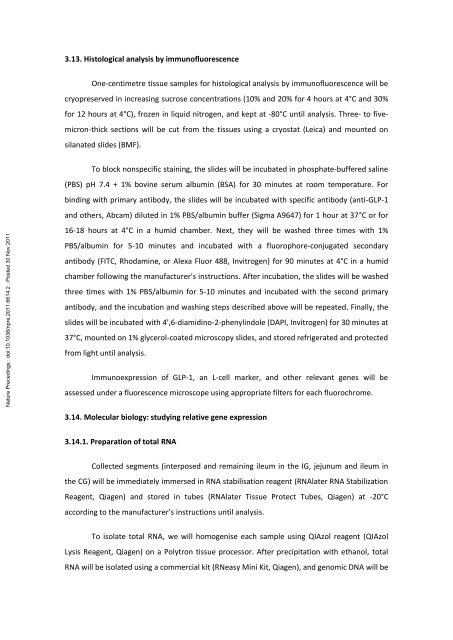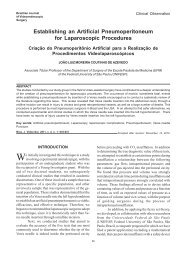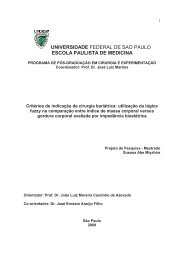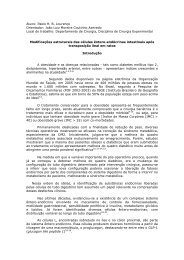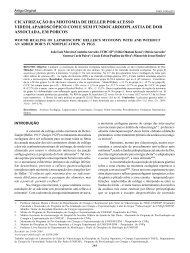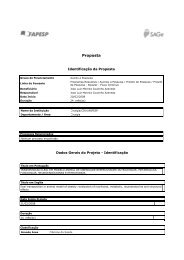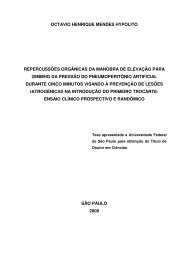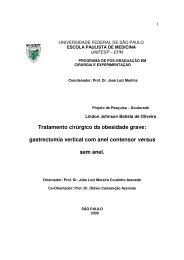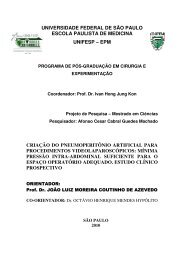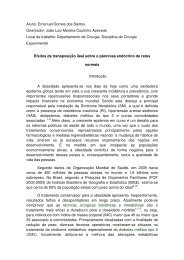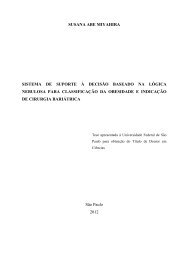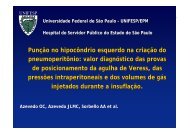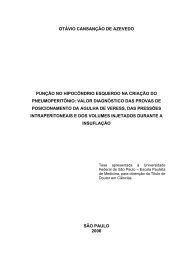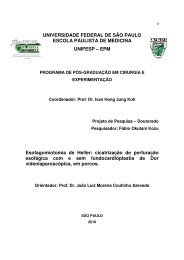Isolated ileal interposition in enteroendocrine L cells differentiation
Isolated ileal interposition in enteroendocrine L cells differentiation
Isolated ileal interposition in enteroendocrine L cells differentiation
You also want an ePaper? Increase the reach of your titles
YUMPU automatically turns print PDFs into web optimized ePapers that Google loves.
3.13. Histological analysis by immunofluorescence<br />
One-centimetre tissue samples for histological analysis by immunofluorescence will be<br />
cryopreserved <strong>in</strong> <strong>in</strong>creas<strong>in</strong>g sucrose concentrations (10% and 20% for 4 hours at 4°C and 30%<br />
for 12 hours at 4°C), frozen <strong>in</strong> liquid nitrogen, and kept at -80°C until analysis. Three- to fivemicron-thick<br />
sections will be cut from the tissues us<strong>in</strong>g a cryostat (Leica) and mounted on<br />
silanated slides (BMF).<br />
To block nonspecific sta<strong>in</strong><strong>in</strong>g, the slides will be <strong>in</strong>cubated <strong>in</strong> phosphate-buffered sal<strong>in</strong>e<br />
(PBS) pH 7.4 + 1% bov<strong>in</strong>e serum album<strong>in</strong> (BSA) for 30 m<strong>in</strong>utes at room temperature. For<br />
b<strong>in</strong>d<strong>in</strong>g with primary antibody, the slides will be <strong>in</strong>cubated with specific antibody (anti-GLP-1<br />
Nature Preced<strong>in</strong>gs : doi:10.1038/npre.2011.6614.2 : Posted 30 Nov 2011<br />
and others, Abcam) diluted <strong>in</strong> 1% PBS/album<strong>in</strong> buffer (Sigma A9647) for 1 hour at 37°C or for<br />
16-18 hours at 4°C <strong>in</strong> a humid chamber. Next, they will be washed three times with 1%<br />
PBS/album<strong>in</strong> for 5-10 m<strong>in</strong>utes and <strong>in</strong>cubated with a fluorophore-conjugated secondary<br />
antibody (FITC, Rhodam<strong>in</strong>e, or Alexa Fluor 488, Invitrogen) for 90 m<strong>in</strong>utes at 4°C <strong>in</strong> a humid<br />
chamber follow<strong>in</strong>g the manufacturer's <strong>in</strong>structions. After <strong>in</strong>cubation, the slides will be washed<br />
three times with 1% PBS/album<strong>in</strong> for 5-10 m<strong>in</strong>utes and <strong>in</strong>cubated with the second primary<br />
antibody, and the <strong>in</strong>cubation and wash<strong>in</strong>g steps described above will be repeated. F<strong>in</strong>ally, the<br />
slides will be <strong>in</strong>cubated with 4',6-diamid<strong>in</strong>o-2-phenyl<strong>in</strong>dole (DAPI, Invitrogen) for 30 m<strong>in</strong>utes at<br />
37°C, mounted on 1% glycerol-coated microscopy slides, and stored refrigerated and protected<br />
from light until analysis.<br />
Immunoexpression of GLP-1, an L-cell marker, and other relevant genes will be<br />
assessed under a fluorescence microscope us<strong>in</strong>g appropriate filters for each fluorochrome.<br />
3.14. Molecular biology: study<strong>in</strong>g relative gene expression<br />
3.14.1. Preparation of total RNA<br />
Collected segments (<strong>in</strong>terposed and rema<strong>in</strong><strong>in</strong>g ileum <strong>in</strong> the IG, jejunum and ileum <strong>in</strong><br />
the CG) will be immediately immersed <strong>in</strong> RNA stabilisation reagent (RNAlater RNA Stabilization<br />
Reagent, Qiagen) and stored <strong>in</strong> tubes (RNAlater Tissue Protect Tubes, Qiagen) at -20°C<br />
accord<strong>in</strong>g to the manufacturer’s <strong>in</strong>structions until analysis.<br />
To isolate total RNA, we will homogenise each sample us<strong>in</strong>g QIAzol reagent (QIAzol<br />
Lysis Reagent, Qiagen) on a Polytron tissue processor. After precipitation with ethanol, total<br />
RNA will be isolated us<strong>in</strong>g a commercial kit (RNeasy M<strong>in</strong>i Kit, Qiagen), and genomic DNA will be


